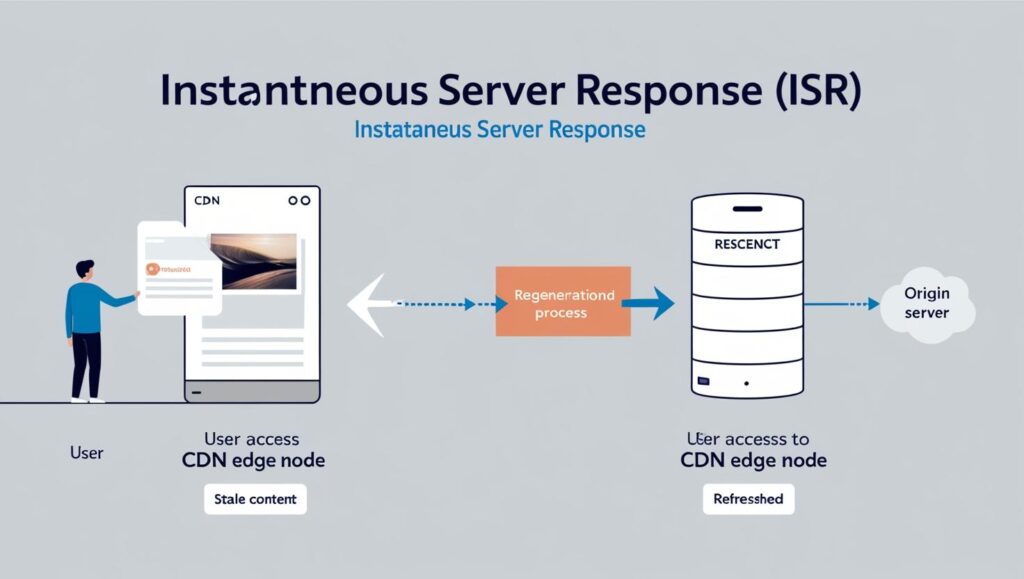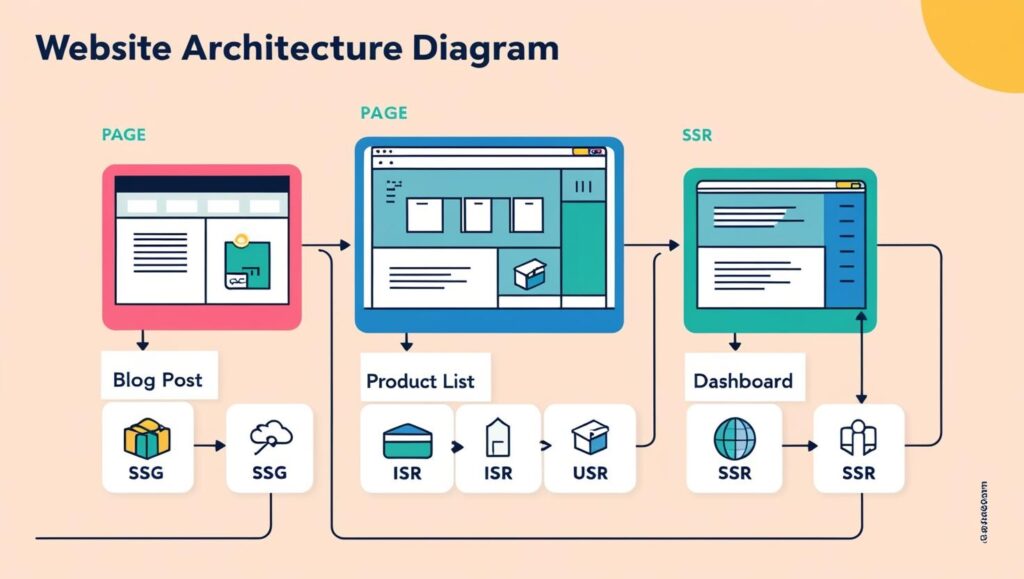Alright fellow web devs, let’s talk rendering. In 2025, building fast, SEO-friendly websites isn’t just a goal, it’s an expectation. Users demand instant loads, and search engines reward performance. Thankfully, modern frameworks like Next.js and Nuxt.js give us powerful tools to control exactly how our pages are rendered and delivered. Gone are the days of choosing only between slow server rendering or SEO-unfriendly client-side rendering.
Today, the conversation often revolves around three key strategies: Server-Side Rendering (SSR), Static Site Generation (SSG), and Incremental Static Regeneration (ISR). But what do they actually mean, and more importantly, when should you use which one for optimal performance? Let’s dive in.
1. Server-Side Rendering (SSR): Fresh Content, On Demand
- What it is: With SSR, every time a user requests a page, the server does the work. It fetches the necessary data, builds the full HTML page for that specific request, and then sends it to the user’s browser.
- The Pros:
- Always Fresh: Content is generated live on each request, so it’s always up-to-date. Perfect for highly dynamic data or personalized content (like a user dashboard).
- Great for SEO: Search engine crawlers receive a fully rendered HTML page immediately, making indexing straightforward.
- Good Initial Load: Users see meaningful content relatively quickly (good First Contentful Paint – FCP).
- The Cons:
- Slower Time To First Byte (TTFB): The server has to compute the page before sending anything, which can delay the start of the page load.
- Server Load: Can be demanding on the server, especially under high traffic, potentially requiring more robust (and costly) hosting infrastructure.
- Requires a Running Server: Unlike static sites, you need a server environment (like Node.js) constantly running to handle requests.
- Framework Use (e.g., Next.js/Nuxt.js): Frameworks abstract away much of the complexity. In Next.js Pages Router, this was
getServerSideProps. In the App Router, it’s achieved by using dynamic functions or opting out of caching. Nuxt.js also has built-in SSR capabilities.
2. Static Site Generation (SSG): Built for Speed and Scale
- What it is: SSG takes the opposite approach. The entire website is pre-rendered into static HTML, CSS, and JavaScript files during the build process (when you deploy your site). These files are then deployed and served globally from a Content Delivery Network (CDN).
- The Pros:
- Warp Speed: Unbeatable performance. Pages load almost instantly because they are just static files served from a CDN edge server close to the user (great for reaching users in Chennai or anywhere else quickly!). Lowest possible TTFB.
- Highly Scalable & Resilient: CDNs can handle massive traffic spikes easily, and the site remains available even if your origin server goes down.
- Cost-Effective: Hosting static files is typically very cheap.
- Excellent for SEO: Search engines love fast-loading, fully available HTML.
- Secure: Minimal server-side attack surface, as there’s no database or server code running per request at the edge.
- The Cons:
- Stale Content: The content is only as fresh as your last build/deployment. Frequent updates require frequent rebuilds.
- Not for Dynamic/Personalized Data: Doesn’t work well for content that changes per user or in real-time without adding client-side logic.
- Build Times: For very large sites (thousands of pages), the initial build process can become lengthy.
- Framework Use (e.g., Next.js/Nuxt.js): This is often the default or easiest mode in modern frameworks. Next.js Pages Router used
getStaticProps. The App Router defaults to static rendering for components unless dynamic functions are detected. Nuxt.js can generate fully static sites vianuxi generate. Perfect for blogs, documentation sites, marketing pages, portfolios.
3. Incremental Static Regeneration (ISR): The Smart Hybrid
- What it is: ISR, popularized by Next.js, offers a clever middle ground. Pages are initially generated statically (like SSG), reaping the speed benefits. However, you can configure them to re-generate automatically in the background after a certain time interval (e.g., every 60 seconds) or on-demand (via a webhook trigger). When a request comes in after the timeout, the user gets the existing static (stale) page instantly, while Next.js regenerates the page in the background with fresh data. The next user then gets the updated page.
- The Pros:
- Fast Like Static: Delivers the near-instant load times and CDN benefits of SSG for most users.
- Content Freshness (Eventually): Allows static pages to be updated with new data without requiring a full site rebuild and deployment.
- Reduced Build Times: Great for large sites where rebuilding thousands of pages frequently is impractical.
- Good for SEO: Still serves highly performant, crawlable HTML pages.
- The Cons:
- Potential Stale Content: Users might briefly see slightly outdated information while the page revalidates in the background.
- Requires Serverless Functions: Needs infrastructure capable of running functions (like Vercel, Netlify, AWS Lambda) to handle the background regeneration.
- Slightly More Complex: Adds a layer of configuration (the revalidation logic) compared to pure SSG.
- Framework Use (e.g., Next.js/Nuxt.js): Implemented in Next.js via the
revalidateoption withingetStaticProps(Pages Router) or fetch options (App Router). Excellent for e-commerce category pages, news headlines, social media feeds, dashboards – content that changes, but where millisecond real-time freshness isn’t absolutely critical.

Don’t Forget Client-Side Rendering (CSR)
It’s worth remembering the traditional approach where the browser downloads a minimal HTML file and JavaScript, which then fetches data and renders the page. While great for highly interactive web applications after the initial load, CSR often suffers from slower initial load times (the dreaded blank screen) and can present challenges for SEO. Modern frameworks often use CSR for parts of the page or subsequent navigation after an initial SSR/SSG load (this is called hydration).
Choosing Your Strategy in 2025: Mix and Match!
The best part about using modern frameworks like Next.js and Nuxt.js is that you usually don’t have to choose just one strategy for your entire application. You can apply the best approach on a per-page basis:
- Go Static (SSG) First: If the content rarely changes (e.g., About Us, Contact, Privacy Policy, individual blog posts), make it static. It’s the fastest, cheapest, and simplest.
- Use ISR for Periodic Updates: If a page is mostly static but needs to reflect new data occasionally without a full rebuild (e.g., a product listing page, news feed), ISR is often the perfect balance.
- Choose SSR for Truly Dynamic Needs: If the data must be fresh on every single request or is highly personalized (e.g., user account details, shopping cart, real-time data displays), SSR is the way to go.
- Leverage CSR for App Interactivity: For highly dynamic components within a page or sections of a web application where initial SEO isn’t the primary concern (like a complex settings dashboard after login), CSR remains a valid choice.

Conclusion: Render Wisely
In 2025, SSR, SSG, and ISR aren’t just technical acronyms; they are powerful techniques for optimizing web performance and user experience. Frameworks like Next.js and Nuxt.js put these tools directly in developers’ hands. By understanding the trade-offs between data freshness, server load, build times, and complexity, you can make informed decisions – page by page – to build websites and applications that are fast, scalable, SEO-friendly, and delight users, whether they’re accessing your site from Chennai or anywhere else on the globe.
